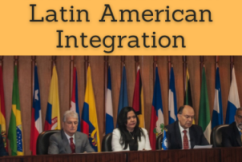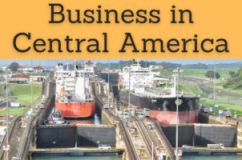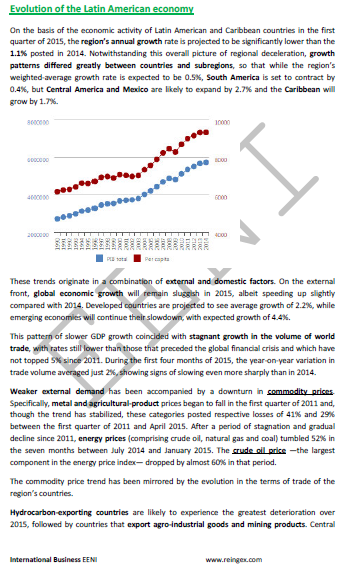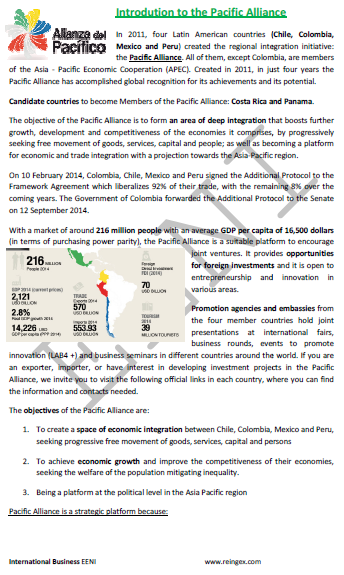Latin American Economic Area. Western Civilization

Economic Integration in Latin America, MERCOSUR, Andean Community
- Introduction to the Latin American Economic Area of the Western Civilization
- Economic Profile of the Latin American Countries
- Latin American Economic Integration Processes (Western Civilization, American, Economic Organizations, Trade Agreements)
- Interactions with the other civilizations.
- ALADI
- Economic Integration in South America
- The case of Chile
- Andean Countries
- The case of Mexico
- Economic Integration in Central America
- Other Economic Institutions and Trade Agreements related to the integration in Latin America (Iberian America)
- Relations between Latin America and Europe, Asia, the Arab Countries, Africa
The objectives of the subject “Latin American Economic Area” are the following:
- To define the characteristics of the Latin American Economic Area of the Western Civilization
- To analyze the influence of Christianity on the Latin American Economic Area
- To know the economic profile of the Latin American Countries
- To analyze the businesspeople profile in the Latin American Economic Area
- To understand the economic integration process in Latin America (Western Civilization)
- To know the economic relations with the other civilizations (Sinic, Hindu, Islamic, African, Buddhist) and with the other areas of the Western Civilization (Europe, Caribbean, U.S.)
- To analyze the main Economic Organizations related to the Latin American Economic Area

The Subject “Latin American Economic Area (Western-Christian Civilization)” belongs to the following Online Programs taught by EENI Global Business School:
Masters: International Business, Foreign Trade, Religions & Business.
Doctorate: Ethics, Religions & Business, American Business, World Trade.
Course: Christianity & Business.

Why study “Christianity and Business”?.
Languages:  or
or  Civilización América Latina
Civilización América Latina  Civilizacion Amerique Latine
Civilizacion Amerique Latine  Civilização Latino-Americana.
Civilização Latino-Americana.
- Credits of the Subject “Latin American Economic Area”: 4

- Duration: 4 weeks
Download the Syllabus of the Subject “Latin American Economic Area” (PDF).

1- Introduction to the Latin American Economic Area of the Western Civilization
- South American sub-continent
- Christianity in Latin America (Iberian America)
- Latin American Countries
- Latin American Economy

2- Processes of the Latin American Economic Integration of the Western Civilization (Economic Organizations, Trade Agreements) and the interactions with the other civilizations.
2.1- Latin American Integration Association (ALADI).

2.2- Integration in South America.

- Introduction to the MERCOSUR
- Member countries of the MERCOSUR: Argentina, Brazil, Paraguay, and Uruguay
- Incorporation of Bolivia (accession process) and Venezuela
- MERCOSUR Interactions with
- Christian Civilization
- European Economic Area: EU-Mercosur
- Latin American Economic Area: Chile, Andean Community, Mexico, and Peru
- Hindu Civilization: India
- With the Islamic Civilization / African Civilization: Egypt
- With the African Civilization: Agreement with the Southern African Customs Union (Not in force)
- With Israel
- Africa-BRICS Cooperation (Brazil)
- Christian Civilization
2.3- The Case of Chile (40% of the Chilean foreign trade is made with Asia).
- Chilean integration and FTAs with the Western Civilization
- Agreement with the Islamic Civilization: FTA with Turkey
- Agreements with the Sinic-Buddhist Civilization: China, Japan, and South Korea
- Agreements with the Hindu Civilization: India
- Inter-civilization Agreements:

2.4- Andean Countries.
- Andean Community
- Andean Countries: Bolivia, Colombia, Ecuador, and Peru
- Integration and Trade Agreements with:
- Christian Civilization - Latin America:
- The Andean Community has agreements with the MERCOSUR, Chile, Mexico, and Panama
- ALADI (all countries of the Andean Community), Chile-Ecuador
- Colombian FTA: Mexico, Chile, the CARICOM, and the Northern Triangle (El Salvador, Guatemala, and Honduras)
- Peruvian FTA: MERCOSUR, Chile
- Christian Civilization - North America:
- United States (FTA): United States-Colombia, United States-Peru Agreement
- Canada (FTA): Colombia-Canada, Peru-Canada Agreement
- Christian Civilization - European: Association Agreement with the EU (EU-Colombia, Peru), Colombia-EFTA FTA and Peru-EFTA Agreement
- Hindu Civilization: India
- Orthodox Civilization: Russia
- Sinic - Buddhist Civilization: Andean Community-China. Peru has agreements with China, Singapore, and South Korea
- Peruvian inter-civilization Agreements: APEC and TPP
- Christian Civilization - Latin America:

2.5- The case of Mexico: a Latin American country with the most FTA and a member of the U.S.MCA/NAFTA 2.0.
- Mexican Market
- Mexican Agreements
- Mexican integration and trade agreements with the Western Civilization:
- Latin America: ALADI, Northern Triangle, Colombia, Costa Rica, Nicaragua, Uruguay, Chile, MERCOSUR, Andean Community, Peru, and Ecuador
- North America: USMCA/NAFTA 2.0
- Europe: EU, EFTA
- Mexican Agreements with the Sinic Civilization - Buddhist: Japan
- Agreement with Israel
- Inter-civilization Agreements:
- APEC
- Comprehensive and Progressive Agreement for Trans-Pacific Partnership (CPTPP)


2.6- Central America.
- Economy of Central America
- Central American Common Market - Integrated with the SICA -
- Central American Integration System
- Central American Countries: Belize, Costa Rica, El Salvador, Honduras, Guatemala, Nicaragua, and Panama. The Dominican Republic
- The case of Guyana and Suriname
- Central America Free Trade Agreements
- Agreements with the Western Civilization
- Latin America:
FTA agreements with Panama, Central America and the Dominican Republic. Nicaragua and Costa Rica have a Free Trade Agreement with Mexico. Panama has a Trade Agreement with Chile. Andean Community-Panama
The Northern Triangle countries Agreements (El Salvador, Guatemala, and Honduras) with Mexico and Colombia - North America: CAFTA-DR agreement (United States-Central America-Dominican Republic), Honduras-Canada, Canada-Costa Rica, Panama-Canada, United States-Panama Agreement
- The Caribbean: Caribbean Community-Costa Rica Agreement
- Europe: Association Agreement with the EU, EFTA-Central America
- Latin America:
FTA agreements with Panama, Central America and the Dominican Republic. Nicaragua and Costa Rica have a Free Trade Agreement with Mexico. Panama has a Trade Agreement with Chile. Andean Community-Panama
- Agreements with the Sinic Civilization.
- Taiwan has trade agreements with Honduras and El Salvador, Guatemala, Nicaragua, and Panama
- China-Costa Rica Agreement
- Singapore-Panama Agreement
- Agreements with the Western Civilization
Other Economic Institutions and Organizations related to the integration in Latin America.
- OAS
- CELAC
- Inter-American Development Bank
- ECLAC
- Latin American and Caribbean Economic System
- Union of South American Nations (UNASUR)
- ALBA
- Mesoamerica Project
- Association of Caribbean States
- CARICOM
Relationships of Latin America with Asia, the Muslim Countries, and Africa.
- FEALAC
- Summit of South American-Arab Countries
- Africa-South America Summit

The Latin American Countries seek to integrate their economies. Several integration projects are underway: UNASUR, ALADI, ALBA, MERCOSUR, and the Andean Community. Latin America seeks its identity based on a common history (former colonies), Language (Spanish and Portuguese), religious (Christianity), ethnic (although we should consider the existence of different ethnic groups).
Latin America differs from other areas of the Western Civilization in several aspects: influence of the Amerindian religions, no influence of Protestant Reformation, the Latin American Countries were colonies rather than colonisers.
Christianity is the main religion of Latin America. Latin America has been eminently Catholic, but Protestantism is becoming increasingly important.
The Latin American Countries of the Pacific are increasingly turning to the Asia-Pacific region (Chile, Peru, and Mexico belong to the APEC). Perhaps Mexico is an exception (member of the U.S.MCA/NAFTA 2.0). Surely, Brazil is becoming the Central State.
Several Latin American civilizations had arisen in pre-Columbian times. Arnold Toynbee identified four pre-Columbian civilizations: the Andean civilization (the Universal State was the Inca Empire, and Inca religion -Viracocha-), Maya (Mayan religions, polytheistic), Mexican and Yucatan (absorbed by the Mexican), none has survived. Although it should also be considered Olmec civilization (Mexico).

(c) EENI Global Business School (1995-2024)
We do not use cookies
Top of this page



